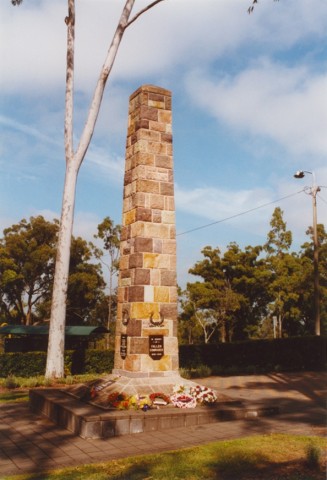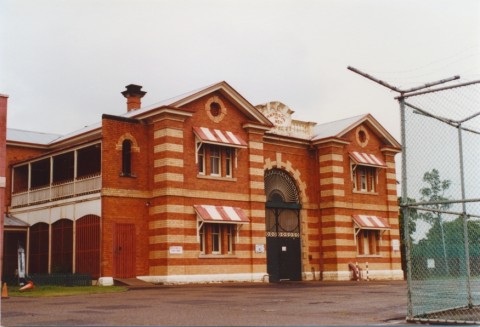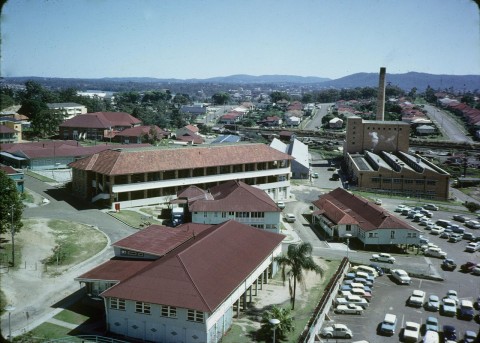Dutton Park, an inner suburb, is 3 km south of central Brisbane. The actual park was a space reserved in 1884 for recreation and named after the Secretary of Public Lands, Charles Boydell Dutton, who held the office during 1883-87. Dutton was a squatter in the Tambo district but won respect as a reformer of the land laws and earned the hostility of squatting interests.
The parkland is next to the South Brisbane cemetery (1870) which opened during the period when the Milton Cemetery was considered to be too close to the built-up areas. Both the cemetery and Dutton Park run down from Gladstone Road to the Brisbane River, and the cemetery is listed on the Queensland heritage register.
In the 1880s several houses were built along Gladstone Road overlooking the river, and the new gaol was opened in Annerley Road (formally Boggo Road) in 1883. Next door the Dutton Park primary school was opened in 1884. Just beyond the gaol the Diamantina Orphanage was opened in 1883, later evolving as a blind, deaf and dumb institute, the Diamantina hospital for chronic diseases (1901) and the Princess Alexandra hospital (1956). The concentration of institutional uses, industrial uses (including Webster's, Davey's and Spearritt's bakeries) left limited scope for residential development. Dutton Park was on the route to more preferred residential suburbs: a tram lime was opened along Gladstone Road to Dutton Park (1901) and later along Cornwall Street to join the Ipswich Road tram to the Thomson Estate (Annerley). The park, however, was a popular destination where the Tramways had a band and an amusement area (1904). Later a river baths (1916-32) was opened at the bottom of Dutton Park.
A complex array of railway tracks grew on the eastern boundary of the gaol. The South Coast line (1884-89) ran via Dutton Park along a line which passed through Wooloongabba to Stanley Street. In 1891 a second line was run through to Park Road and Gloucester Street to South Brisbane. A third line (1889) branched off the Wooloongabba route to the eastern suburbs of Buranda and Cooparoo, ending at Cleveland. There were also brief sidings and stopping places for timber yards.
St Ita's Catholic church and primary school (1919) in Gladstone Road was joined by a girls high school, conducted by St Ita's convent in Highgate Hill. It is now a primary school with about 350 pupils. There is also an adjoining centre for Catholic education. Gair Park (1936) at the junction of Gladstone and Annerley Roads has an elegant cenotaph, and is on the Queensland heritage register.
Along with its local industries, Dutton Park had ready access to manufacturing and government employment in Wooloongabba and South Brisbane. For shopping, residents also had the tram down to Chardon's corner and the Junction, Annerley.
A ferry at Dutton Park put residents within a brief journey to the University of Queensland across the river at St Lucia and was replaced by the 'Green Bridge' (buses, cyclists and pedestrians only) in 2007. The Boggo Road gaol decommissioned in 1989 is the site of a science complex and an 'urban village'. The gaol buildings (mostly 1901-03) are kept as a museum and are listed on the Australian heritage register.
Floods 2011
Dutton Park’s topography mostly ascends to ridge lines, but at a few points descends to inlet watercourses or seepage lines on the Brisbane River. In accord with past events, parts of South Brisbane cemetery and the adjoining park went under water in January 2011.
The Newman government planned to close the Dutton Park railway station as part of its short-lived proposed BaT (Bus and Train) tunnel in 2014 but changed the decision following community opposition.
Dutton Park's recorded census populations have been:
| Census Date | Population |
|---|---|
| 1976 | 2320 |
| 1991 | 1718 |
| 2001 | 1319 |
| 2006 | 1363 |
| 2011 | 1471 |
The population in 2001 was somewhat older than the general profile for metropolitan Brisbane, 37 years compared with 34. The median weekly income per resident then was 30% less than the median for metropolitan Brisbane. These 2001 figures suggest a significant proportion of lone or elderly-person households, but the socio-economic profile changed by the 2011 census when the median age dropped to 34 and median incomes had risen well above the state and national median levels.
Christopher Dawson, Absolute fairyland: heady days in Dutton Park, Annerley, 2006
Mary Joan Ord, A bridge and a resting place: the Ursulines at Dutton Park 1919-1980, Toowoomba, 1981



